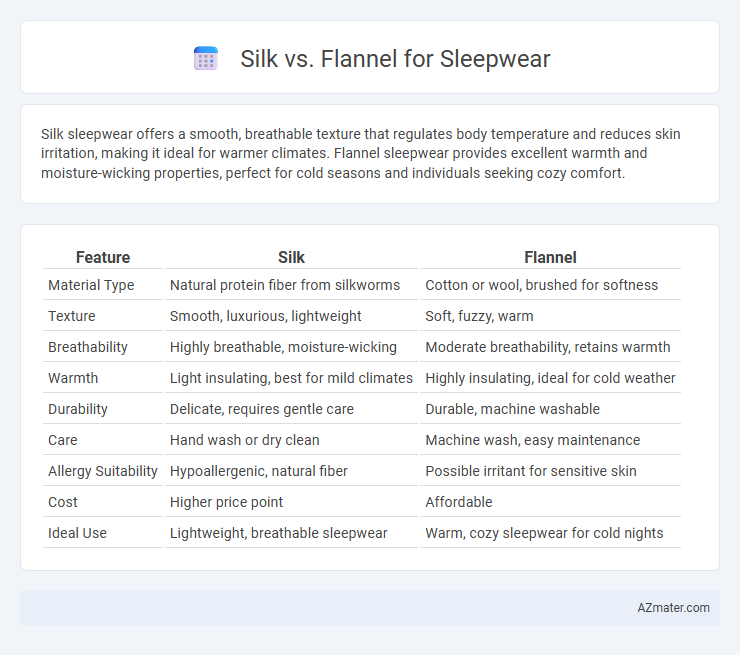Silk sleepwear offers a smooth, breathable texture that regulates body temperature and reduces skin irritation, making it ideal for warmer climates. Flannel sleepwear provides excellent warmth and moisture-wicking properties, perfect for cold seasons and individuals seeking cozy comfort.
Table of Comparison
| Feature | Silk | Flannel |
|---|---|---|
| Material Type | Natural protein fiber from silkworms | Cotton or wool, brushed for softness |
| Texture | Smooth, luxurious, lightweight | Soft, fuzzy, warm |
| Breathability | Highly breathable, moisture-wicking | Moderate breathability, retains warmth |
| Warmth | Light insulating, best for mild climates | Highly insulating, ideal for cold weather |
| Durability | Delicate, requires gentle care | Durable, machine washable |
| Care | Hand wash or dry clean | Machine wash, easy maintenance |
| Allergy Suitability | Hypoallergenic, natural fiber | Possible irritant for sensitive skin |
| Cost | Higher price point | Affordable |
| Ideal Use | Lightweight, breathable sleepwear | Warm, cozy sleepwear for cold nights |
Introduction: Choosing the Perfect Sleepwear
Silk sleepwear offers a smooth, breathable fabric that naturally regulates body temperature, making it ideal for year-round comfort. Flannel sleepwear provides warmth and softness, perfect for cooler nights and cozy relaxation. Selecting between silk and flannel depends on personal preference for temperature control and fabric texture during sleep.
Silk vs Flannel: Key Fabric Differences
Silk offers a smooth, breathable texture that regulates temperature and wicks moisture, making it ideal for warm sleepers or humid climates. Flannel, woven from cotton or wool with a brushed surface, provides superior insulation and softness, perfect for cold weather and cozy comfort. The key fabric differences include silk's lightweight, hypoallergenic properties versus flannel's heavier, insulating nature and durability.
Breathability and Temperature Regulation
Silk sleepwear excels in breathability due to its natural protein fibers, allowing moisture to wick away and keep the body cool in warm temperatures. Flannel, made from brushed cotton or wool, provides superior insulation by trapping heat, making it ideal for colder climates or winter months. Choosing silk or flannel sleepwear directly impacts temperature regulation, influencing overall comfort and sleep quality based on environmental conditions.
Comfort and Skin Sensitivity
Silk offers a smooth, hypoallergenic fabric that naturally regulates temperature, making it ideal for sensitive skin and providing luxurious comfort during sleep. Flannel, known for its soft, brushed texture and insulating properties, excels in warmth and coziness, particularly suitable for colder climates but may cause irritation for those with very sensitive skin. Choosing between silk and flannel sleepwear depends on personal comfort needs, skin sensitivity levels, and seasonal preferences.
Moisture Wicking and Absorption
Silk sleepwear offers moderate moisture-wicking capabilities, drawing sweat away from the skin while maintaining a smooth, breathable texture. Flannel sleepwear excels in moisture absorption due to its dense, brushed fibers, effectively trapping warmth and moisture but potentially feeling damp longer. Choosing between silk and flannel depends on personal preference for temperature regulation and moisture management during sleep.
Durability and Longevity
Flannel sleepwear is known for its durability due to the tightly woven cotton fibers that resist wear and tear, making it ideal for long-term use. Silk, though luxurious and gentle on the skin, requires delicate care and is prone to snagging and deterioration over time. For longevity, flannel outperforms silk as it withstands repeated washing and everyday movement without significant damage.
Seasonal Suitability: Summer vs Winter
Silk sleepwear excels in summer due to its natural breathability and moisture-wicking properties, keeping the body cool and comfortable during hot nights. Flannel, made from brushed cotton or wool, provides superior insulation and warmth, making it ideal for cold winter months. Choosing silk for summer and flannel for winter ensures optimal temperature regulation and comfort throughout the year.
Style and Appearance
Silk sleepwear exudes a luxurious, glossy sheen that enhances elegance, making it a top choice for stylish nightwear with a smooth, draping silhouette. Flannel offers a cozy, matte texture with a rustic charm, often featuring plaid patterns that evoke warmth and casual comfort. The choice between silk's sleek sophistication and flannel's inviting softness reflects a preference for either refined glamour or relaxed homeliness in sleepwear aesthetics.
Maintenance and Care Instructions
Silk sleepwear requires delicate care, including hand washing with mild detergent or using a gentle cycle in cold water, and air drying to preserve its natural fibers and sheen. Flannel sleepwear is more resilient, allowing machine washing in warm water and tumble drying on low heat, making it easier to maintain without special treatment. Proper care for both fabrics extends their lifespan and ensures comfort, with silk demanding more attention to avoid damage.
Price Comparison and Value
Silk sleepwear tends to be more expensive due to its luxurious feel and natural temperature-regulating properties, often costing three to five times more than flannel options. Flannel sleepwear provides exceptional warmth and durability at a budget-friendly price, making it a practical choice for colder climates. Choosing between silk and flannel depends on whether you prioritize long-term comfort and elegance or affordability and warmth when investing in sleepwear.

Infographic: Silk vs Flannel for Sleepwear
 azmater.com
azmater.com